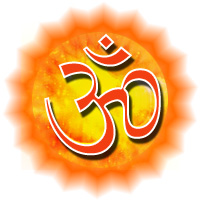Om
By Krishna Maheshwari
Om is a solemn and sacred exclamation. Chanting Om is a purifying experience. It is also transliterated into English as "Aum." The three syllable A+U+M represents and salutes Brahma, Vishnu, and Mahesh and invokes their blessings. The three syllable also represents the three Vedas-Rig Veda, Yjur Veda and Sama Veda.
Om is the source of all religions and religious scriptures. The uttering of the sacred and mystical Om is called Onkar or Omkar. It is the sound of Brahma. It is the predominating force and power. For this reason, chanting Om before every auspicious activity is essential. Most mantras start with Om and much is written on this topic in the scriptures. Eight of the Upanishads have sections dealing with Om. These are
- Brihadaranyaka Upanishad
- Chandogya Upanishad
- Katha Upanishad
- Mandukya Upanishad
- Mundaka Upanishad
- Prashna Upanishad
- Svetasvatara Upanishad
- Taittiriya Upanishad
Om is also discussed in the
- Bhagavad Gita
- Yoga Sutras of Patanjali
- Gopnath Brahman
The Upanishads consider Om as the basis of every other mantra. It is the sound of the origination and dissolution of the universe. The past, present, future and all that transcends time are all included in this sound. According to Taitreya Upanishad the origin of language is assigned to Prajapati, from whose meditation originated the divine syllable of OM, which coordinated all speech and represented the totality of the world.
Om in the Bhagavad Gita[edit]
In the Bhagavad Gita, Lord Krishna states:
I am the syllable Om...I am the sacred monosyllable...Among words, I am the monosyllable Om [1]
His statements imply that Om is not a symbol of God, but IS God. So there can be nothing greater or a subject more important.
In Bhagavad Gita 8.13, Sri Krishna states
Whoever controls his mind and knowing that the souls resides in the forehead repeats the word Om, knowing it as representing Brahma, and thinking of Me his soul leaves the body, that person shall attain the supreme goal.
Chanting Om[edit]
Om must be chanted in a high and prolonged note with great devotion. Chanting produces a quivering sensation and power within. It affects every part of the body. The mind experiences unity and strength. The voice becomes gentle. Negativity in the mind is destroyed. The body feels buoyant. One forgets wordly thoughts. The dormant inner strength is aroused. Self-confidence grows. Since the life force moves vertically, by chanting Om 7,11,21 or 51 times, sadness and disappointments vanish and contentment grows. When chanted in a group, the beneficial influence is multiplied. To ensure physical and emotional strength one must chant Om with a tranquil mind for sometime every day. Even scientists agree that chanting Om is beneficial.
The Sound of Om[edit]
Shiva's drum produced the sound of Om through it came the notes of the octave (SA, RI, GA, MA, PA, DHA, NI). Om is also the sound form of the Atman.
Musically, it is also held that the term OM or AUM is made up by three base notes ' A ' 'U' 'M' or the basic 'SA' 'PA' of the fundamental scale and again Sa (the base note) of the immediately higher scale. When one pronounces these notes in continuity, all the basic notes from Sa to Ni also sound. Similarly when one pronounces AUM correctly, all the basic sounds also echo. It is believed to be the traditional way of clearing all the impediments in the vocal chord to make one chant the hymns correctly. Their unison makes one not only sound sonorous but also acts as the necessary preparation to chant a Mantra (Incantation) correctly.
Om in Dvaita Philosophy[edit]
Vaishnava Dvaita philosophies teach that Aum is an impersonal sound representation of Vishnu/Krishna while Hari Nama is the personal sound representation. A represents Krishna, U Srimati Radharani and M jivas. According to Sridhara Swami the pranava has five parts: A, U, M, the nasal bindu and the reverberation (nada). Liberated souls meditate on the Lord at the end of that reverberation.
Om in Advaita Philosophy[edit]
In Advaita philosophy Om is frequently used to represent three subsumed into one. It implies that our current existence is mithya "falsehood", and that in order to know the full truth we must comprehend the true nature of Brahman. Essentially, when one gains true knowledge, there is no split between knower and known: one becomes knowledge/consciousness itself. In essence, Aum is the signifier of the ultimate truth that all is one.
Om in daily life[edit]
Om is used on a daily basis. It is used to begin the day or any work or a journey. It is found at the head of letters, at the beginning of examination papers and many other places. Om is often worn as a pendant and is enshrined in in every temple premise as well in all family shrines. A new born child is ushered into the world with this sign. After birth, the child is ritually cleansed and the sacred syllable Om is written on its tongue with honey. Om is also a popular symbol used in contemporary body art and tattoos.
References[edit]
- ↑ Bhagawad Gita 7.8, 9.17, 10.25
Other Resources[edit]
- "Hindu Rites, Rituals, Customs & Traditions" by Prem Bhalla
- "Om in the Upanishads, Bhagavad Gita, and Yoga Sutras" by Swami Nirmalananda Giri
- Om
- "Om: Symbol of the Absolute" by Subhamoy Das


